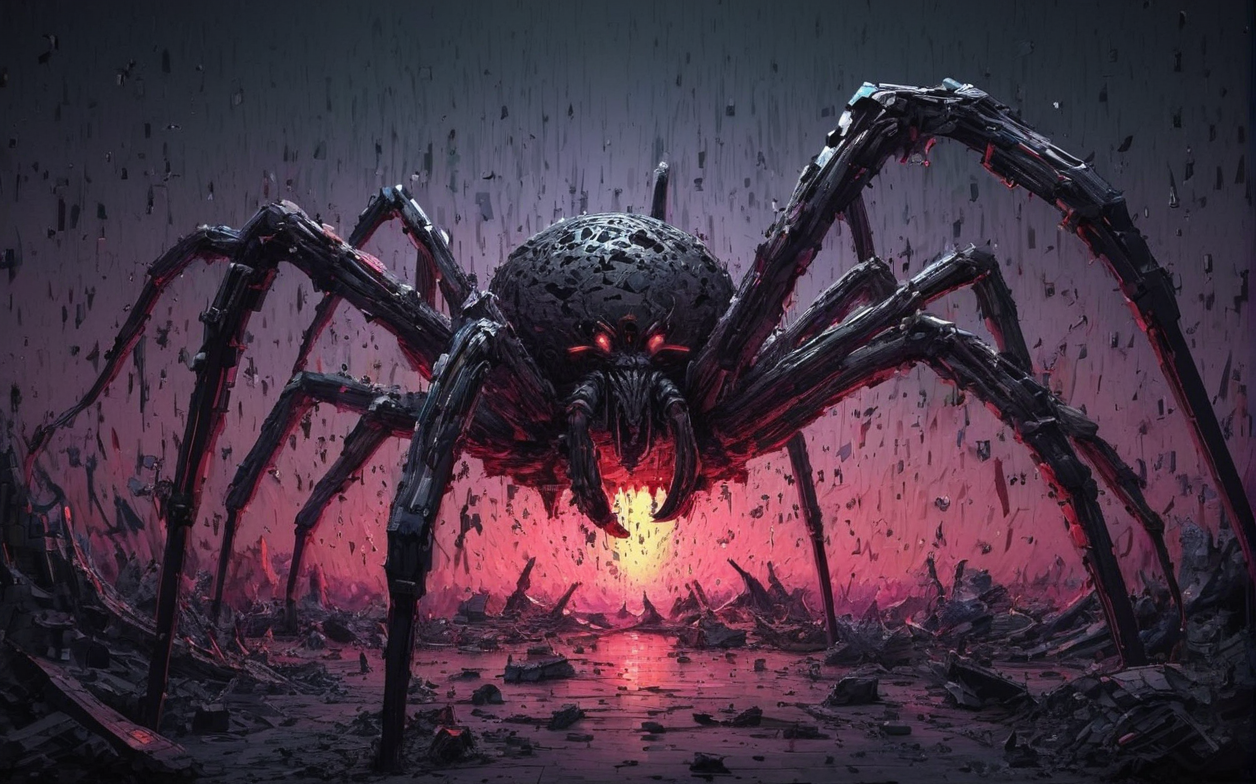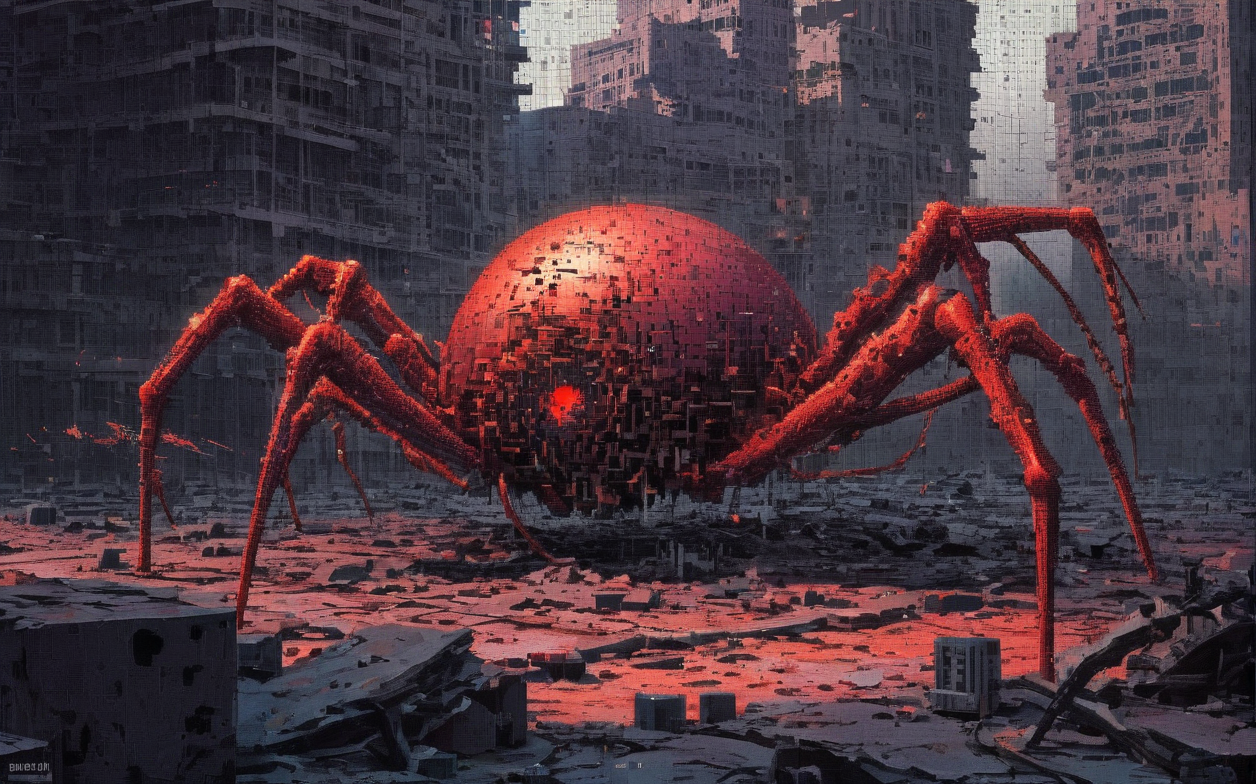I’ve been trying to reproduce the broken pixel style in Stable Diffusion and this is the closest I’ve been able to come. Thoughts?



The original red pixel spider is cool as fuck what is it from
I saw something like it on Deviant Art and it gave me the idea. Not sure where the original artist got the idea from.
And thank you!
What’re the generation parameters? It’ll be a lot easier for people to help if you share them.
I’ll save those next time.
That is one thing I like about GPT is it saves all my stuff where this doesn’t seem to. That said I’m still new with it so I’m probably missing something.
If you have the original output PNG the parameters are all stored on there. You can drag the PNG into the text box on A1111 and press this button to load them for generation or the PNG info tab.
This is the promoting I used on the first spider
The image presents a dystopian scene dominated by a giant spider-like creature. This creature is at the forefront of the image, taking up a significant portion of the space. It has a sleek, almost metallic sheen to its exoskeleton, which is dark and segmented, suggesting a combination of natural and perhaps mechanical elements. Each of its eight legs is adorned with sharp, thorn-like protrusions, and the joints are angled, giving the creature a predatory stance as it looms over the landscape.
Its body is bulky, with a rounded abdomen leading to a narrower thorax, and a head that has two bright red eyes, glowing ominously. Below these eyes, several smaller, dimmer eyes can be seen, adding to its menacing visage. The eyes cast a red hue on its surroundings, indicating its vision is focused and alert. The creature’s mouthparts are not fully visible, but what can be seen appears to be a complex array of mandibles and fangs, hinting at its predatory capabilities.
The background suggests a post-apocalyptic city, with dilapidated buildings that are crumbling and partially collapsed. The architecture of the buildings hints at a once-civilized urban area, now in ruins. There is no visible life or movement other than the monstrous creature, which adds a feeling of desolation and abandonment.
The color palette is dominated by purples and reds, creating an atmosphere of otherworldly danger and destruction. The sky is a deep crimson, with streaks of darker clouds and a faint suggestion of a setting or rising sun, or perhaps a fire burning in the distance. The source of light creates long, dramatic shadows that add to the eerie feeling of the scene.
Electrical wires hang loosely between the buildings, suggesting that this was once a city full of life and energy, now gone silent. The ground is littered with debris, rocks, and dust, and there are tall, dry plants or thin trees that have managed to grow amidst the desolation, their leaves stretching towards the sky, as if in a futile search for light.
The overall impression is one of a world where humanity has fallen, and nature—in a twisted, monstrous form—has begun to reclaim its dominion. The artwork tells a story of a cataclysmic event that has led to the rise of such creatures, or perhaps an invasion that has left the planet forever changed. The image is rich in detail, texture, and color, creating a visual narrative that is both haunting and captivating., Fragmented Aesthetics: The subjects of the images, whether they are figures, animals, landscapes, or objects, appear as though they are disintegrating or have been constructed from fragmented pieces. These pieces resemble pixels or blocks that vary in size and shape, giving the impression of a corrupted digital file or a picture that is not fully loading.
Vibrant Color Contrasts: The style often employs a bold and vibrant color palette. The colors tend to be highly saturated, contrasting sharply with each other. This can be seen in the way the ‘pixels’ stand out against more smoothly rendered parts of the image or the background.
Digital Decay: There’s a sense of decay, as if the digital information of the image itself is breaking down. This might be represented through scattered pixels that drift away from the main subject, suggesting a loss of data or a decomposing effect.
Visual Disruption: The subjects are often intersected by lines and geometric shapes that interrupt their forms. This disruption can be likened to visual interference one might experience with digital screens or signal loss, further emphasizing the digital nature of the art.
Depth and Dimension: Despite the ‘broken’ aspect, there’s a strong sense of depth and three-dimensionality to these images. The pixelated fragments often layer in such a way that they project outwards or recede into the space, creating a dynamic and complex visual field.
Combination of Realism and Abstraction: While parts of each image are rendered in a realistic manner, the glitched pixel elements introduce a level of abstraction. This interplay between the real and the abstract creates a surreal and visually intriguing experience.
Implied Motion: The style often suggests movement, as if the pixels are in the process of breaking apart or coming together. This dynamic quality adds energy and life to the otherwise static images.
Technological Theme: The overall theme evokes thoughts of the digital age and technology, reflecting on the nature of digital media, its potential for corruption, and the transient beauty found in its imperfections. Fragmented Aesthetics: The subjects of the images, whether they are figures, animals, landscapes, or objects, appear as though they are disintegrating or have been constructed from fragmented pieces. These pieces resemble pixels or blocks that vary in size and shape, giving the impression of a corrupted digital file or a picture that is not fully loading.
Vibrant Color Contrasts: The style often employs a bold and vibrant color palette. The colors tend to be highly saturated, contrasting sharply with each other. This can be seen in the way the ‘pixels’ stand out against more smoothly rendered parts of the image or the background.
Digital Decay: There’s a sense of decay, as if the digital information of the image itself is breaking down. This might be represented through scattered pixels that drift away from the main subject, suggesting a loss of data or a decomposing effect.
Visual Disruption: The subjects are often intersected by lines and geometric shapes that interrupt their forms. This disruption can be likened to visual interference one might experience with digital screens or signal loss, further emphasizing the digital nature of the art.
Depth and Dimension: Despite the ‘broken’ aspect, there’s a strong sense of depth and three-dimensionality to these images. The pixelated fragments often layer in such a way that they project outwards or recede into the space, creating a dynamic and complex visual field.
Combination of Realism and Abstraction: While parts of each image are rendered in a realistic manner, the glitched pixel elements introduce a level of abstraction. This interplay between the real and the abstract creates a surreal and visually intriguing experience.
Implied Motion: The style often suggests movement, as if the pixels are in the process of breaking apart or coming together. This dynamic quality adds energy and life to the otherwise static images.
Technological Theme: The overall theme evokes thoughts of the digital age and technology, reflecting on the nature of digital media, its potential for corruption, and the transient beauty found in its imperfections., Chromatic aberration, Chromatic aberration, Chromatic aberration,
Disintegration and Fragmentation: Unlike traditional pixel art, which typically features clean and grid-aligned pixels, this style shows pixels that appear to be breaking away or disintegrating from the main subject. This gives the impression of motion and decay, as if the digital image is being corrupted or affected by a glitch.
Dynamic Flow: There is a sense of movement within the pixels. They often stretch, distort, or flow in a particular direction, as if affected by digital wind or force, creating a stark contrast with the static nature of traditional pixel art.
Color Variation: The color palette often includes gradients and a wide range of hues that blend into each other, creating depth and complexity. This is in contrast to the more limited, solid color blocks of classic pixel art.
Contrast with Realism: In many cases, the broken pixel style is combined with elements of photorealism or highly detailed digital painting, creating a striking juxtaposition between the crisp, detailed areas and the abstract pixelated parts.
Three-Dimensional Effect: The pixels often vary in size and overlap each other, giving the illusion of a three-dimensional form breaking apart into the digital space.
Strategic Placement: The pixelated effect is typically used in specific areas to draw attention or convey a message, while other parts of the image remain clear and detailed.
Abstract Aesthetic: The overall look evokes a sense of abstraction, as the recognizable forms are deconstructed into a digital mosaic, challenging the viewer’s perception.Chromatic aberration, Chromatic aberration, Chromatic aberration,
Disintegration and Fragmentation: Unlike traditional pixel art, which typically features clean and grid-aligned pixels, this style shows pixels that appear to be breaking away or disintegrating from the main subject. This gives the impression of motion and decay, as if the digital image is being corrupted or affected by a glitch.
Dynamic Flow: There is a sense of movement within the pixels. They often stretch, distort, or flow in a particular direction, as if affected by digital wind or force, creating a stark contrast with the static nature of traditional pixel art.
Color Variation: The color palette often includes gradients and a wide range of hues that blend into each other, creating depth and complexity. This is in contrast to the more limited, solid color blocks of classic pixel art.
Contrast with Realism: In many cases, the broken pixel style is combined with elements of photorealism or highly detailed digital painting, creating a striking juxtaposition between the crisp, detailed areas and the abstract pixelated parts.
Three-Dimensional Effect: The pixels often vary in size and overlap each other, giving the illusion of a three-dimensional form breaking apart into the digital space.
Strategic Placement: The pixelated effect is typically used in specific areas to draw attention or convey a message, while other parts of the image remain clear and detailed.
As you can see I repeated myself a lot to get close.
You didn’t use any LoRA or anything? That’s impressive.
No, I’m just starting to play with those but they tend to be really style specific at least as far as I can tell.
You can do a lot of cool things raising and lowering the strength on LoRAs once you figure it out. There’s some good guides in the articles section on Civitai.
Oh badass! Thank you!


